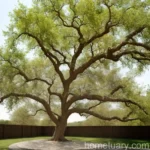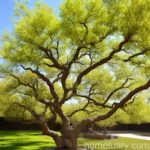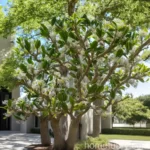Red Oak (Quercus rubra): A Comprehensive Guide
In the world of trees, oaks are revered for their strength, beauty, and longevity, and the red oak (Quercus rubra) stands out as a particularly majestic representative of its genus. As a plant scientist with a passion for trees, I am excited to delve into the intricate details and fascinating aspects of the red oak species. In this comprehensive guide, we will explore everything from its cultural requirements to its uses, diseases, and fascinating facts.
What is Red Oak (Quercus rubra)?
The red oak, scientifically known as Quercus rubra, is a deciduous tree native to North America. It belongs to the Quercus genus and is characterized by its distinctive red foliage in the fall, deeply lobed leaves, and strong, durable wood. As a large oak species, red oak is known for its significant ecological, economic, and cultural importance.
Key Takeaways – Red Oak (Quercus rubra)
Before we dive deeper into the various aspects of red oak cultivation, it’s important to highlight the key takeaways associated with this impressive tree.
- Scientific Name: Quercus rubra
- Common Names: Red oak tree, oak tree
- Species Classification: Deciduous tree, North American oak, native oak species
- Distinct Features: Red oak leaves, red oak bark, tall oak tree, large oak species, strong oak wood
- Habitat: Red oak characteristics, red oak habitat, red oak growth, red oak ecosystem
- Utility: Red oak uses in landscaping, gardening, timber, furniture, lumber, flooring, home decor, carpentry, and woodworking
- Conservation: Red oak ecosystem benefits, conservation, and sustainability
- Ecosystem: Red oak forest, forest management, forest ecology, and forest conservation
- Plant Care: Planting red oak, pruning, and disease and pest management
- Symbolism: Red oak tree benefits and symbolism
- Taxonomy and Life Cycle: Quercus rubra taxonomy, red oak tree life cycle, and propagation
The red oak encompasses a broad range of attributes, each holding its own significance in understanding and appreciating this remarkable tree. Now, let’s delve into the specifics of red oak culture, uses, and care.
Culture
Cultivating red oak requires an understanding of its specific cultural needs, including water, sunlight, fertilizer, soil, and pruning requirements.
Water
Red oak trees generally prefer moist, well-drained soil, especially during their early years of establishment. While they are relatively drought-tolerant once mature, adequate water supply is essential for their initial growth and development. It is important to monitor soil moisture and water the tree deeply during dry periods, ensuring that the root system remains healthy and vigorous.
Sunlight
As a deciduous tree, red oak thrives in full sun to partial shade, requiring at least 6 hours of direct sunlight daily for optimal growth. Planting it in a location with ample sunlight exposure enables the tree to photosynthesize effectively and develop a strong, well-structured canopy.
Fertilizer
Fertilizing red oak trees is typically necessary only if the soil is deficient in essential nutrients. Soil tests can provide insights into the specific fertilizer requirements of the tree, helping determine the appropriate nutrient balance for healthy growth. Slow-release fertilizers applied in early spring or late fall can support the tree’s nutritional needs without causing excessive vegetative growth.
Soil
Red oak trees prefer slightly acidic to neutral soil with a pH range of 5.5 to 6.5. Well-drained, loamy soils are ideal for their growth, as they provide good aeration and water retention while avoiding waterlogging. Adding organic matter such as compost or well-rotted manure can improve soil structure and fertility, creating a conducive environment for red oak development.
Pruning
Pruning red oak trees is essential to promote strong branch structure, remove dead or diseased wood, and shape the tree for aesthetic or functional purposes. Young trees can be selectively pruned to encourage a central leader and well-spaced lateral branches, while mature trees may benefit from light pruning to maintain their form and health.
Uses
Red oak trees are valued for their versatile uses in various aspects of life, ranging from timber production to landscaping and home decor.
Timber
The wood of the red oak tree is highly prized for its strength, durability, and prominent grain patterns. It is commonly used in the production of furniture, flooring, cabinetry, millwork, and interior trim. With its appealing aesthetics and reliable structural properties, red oak lumber is a popular choice for both commercial and residential woodworking projects.
Landscaping
In landscaping, red oak trees are planted for their ornamental value, providing shade, visual interest, and vibrant fall foliage. Their large size and spreading canopy make them suitable for parks, estates, and spacious yards, where they can serve as focal points or focal elements in the landscape design.
Home Decor and Carpentry
The distinctive grain and rich reddish-brown color of red oak wood make it a preferred material for various decorative and functional applications in homes and commercial spaces. Red oak flooring, paneling, molding, and stair treads lend a timeless, natural elegance to interior environments, enhancing the overall aesthetic appeal and value of the spaces.
Sustainability
From an ecological perspective, red oak trees contribute to the sustainability of forest ecosystems by providing habitat, food, and shelter for wildlife, promoting soil health, and sequestering carbon. Sustainable forestry practices and responsible wood utilization are essential for preserving the ecological balance and long-term viability of red oak forests.
Propagation
Propagating red oak trees can be achieved through several methods, including seed sowing, grafting, and rooting cuttings.
Seed Propagation
Harvesting and planting red oak seeds is a common method of propagation, particularly for producing large numbers of seedlings for reforestation and conservation purposes. It is important to ensure that the seeds are stratified and sown in well-prepared soil with appropriate moisture and temperature conditions to facilitate germination and seedling establishment.
Grafting
Grafting allows for the propagation of red oak trees with specific desirable traits, such as disease resistance or unique growth habits. By joining a scion (desired red oak cultivar) to a compatible rootstock, grafting can produce new trees that inherit the desired characteristics of the parent tree, maintaining genetic diversity and improving tree performance.
Rooting Cuttings
Rooting cuttings from a mature red oak tree can be challenging due to the tree’s relatively low success rate in producing viable cuttings. However, with careful selection of healthy, adventitious shoots and proper hormone application, it is possible to encourage root formation and establish new red oak saplings through this method.
Container Popularity
Red oak trees are not commonly grown in containers, as their large size and extensive root system make them more suited for open landscapes and natural settings. However, as part of an experimental or specialized gardening project, it may be feasible to grow young red oak saplings in large containers with proper soil, water, and sunlight management.
Container Common Diseases
While red oak trees are generally resilient and long-lived, they are susceptible to certain diseases that can impact their health and vigor.
Disease Diagnosis
Common diseases that may affect red oak trees include oak wilt, anthracnose, powdery mildew, and various cankers. Proper diagnosis of these diseases involves identifying the symptoms, conducting laboratory tests if necessary, and implementing appropriate treatment measures to mitigate the spread and impact of the diseases.
Oak Wilt
Oak wilt is a particularly concerning disease for red oak trees, causing vascular discoloration, leaf wilting, and canopy dieback. It is essential to monitor for early signs of oak wilt, implement preventive measures such as avoiding pruning during high-risk periods, and promptly address any infections to protect the overall health of red oak stands.
Common Pests
In addition to diseases, red oak trees can be affected by various pests, including oak borers, gypsy moths, and caterpillars. Monitoring for pest activity, implementing integrated pest management strategies, and maintaining tree vigor through proper cultural practices are crucial for minimizing pest damage and preserving the resilience of red oak trees.
Botanist’s Tips
As a botanist, I offer the following tips for enthusiasts and professionals interested in cultivating and appreciating red oak trees:
- Species Selection: When choosing red oak trees for planting, consider the specific site conditions, climate, and intended uses to select suitable cultivars and ensure long-term success.
- Soil Management: Regular soil testing and amendment with organic matter can enhance soil fertility and structure, supporting the vigorous growth and overall health of red oak trees.
- Pruning Techniques: Employ proper pruning techniques to promote structural integrity, reduce disease susceptibility, and maintain the natural form and beauty of red oak trees.
- Conservation Awareness: Support and participate in initiatives focused on red oak conservation, sustainable forestry, and ecosystem preservation to safeguard the vitality and diversity of red oak populations.
Fun Facts
To further appreciate the unique traits and contributions of red oak trees, here are some intriguing fun facts about this remarkable species:
- Red oak wood is commonly used in the production of bourbon barrels, contributing to the aging and flavor enhancement of the distilled spirit.
- The acorns of red oak trees provide a valuable food source for various wildlife species, including squirrels, deer, and birds, contributing to forest biodiversity.
- Red oak leaves turn a vibrant red to russet color in the fall, creating a striking visual display that is highly sought after in landscape design and autumn scenery.
Links to External Resources
For those who wish to explore more about red oak (Quercus rubra) and related topics, the following external resources provide valuable information and insight:
- USDA Plants Database – Quercus rubra
- The Wood Database – Red Oak
- Arbor Day Foundation – Red Oak Tree Guide
- North Carolina State Extension – Red Oak Fertilization
In conclusion, the red oak (Quercus rubra) stands tall as a symbol of strength, resilience, and natural beauty, enriching ecosystems, inspiring craftsmanship, and captivating the senses with its seasonal transformations. As we continue to study, conserve, and celebrate the contributions of red oak trees, may we gain a deeper appreciation for their significance in our world and strive to uphold their enduring legacy for generations to come.















